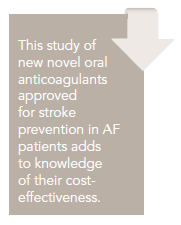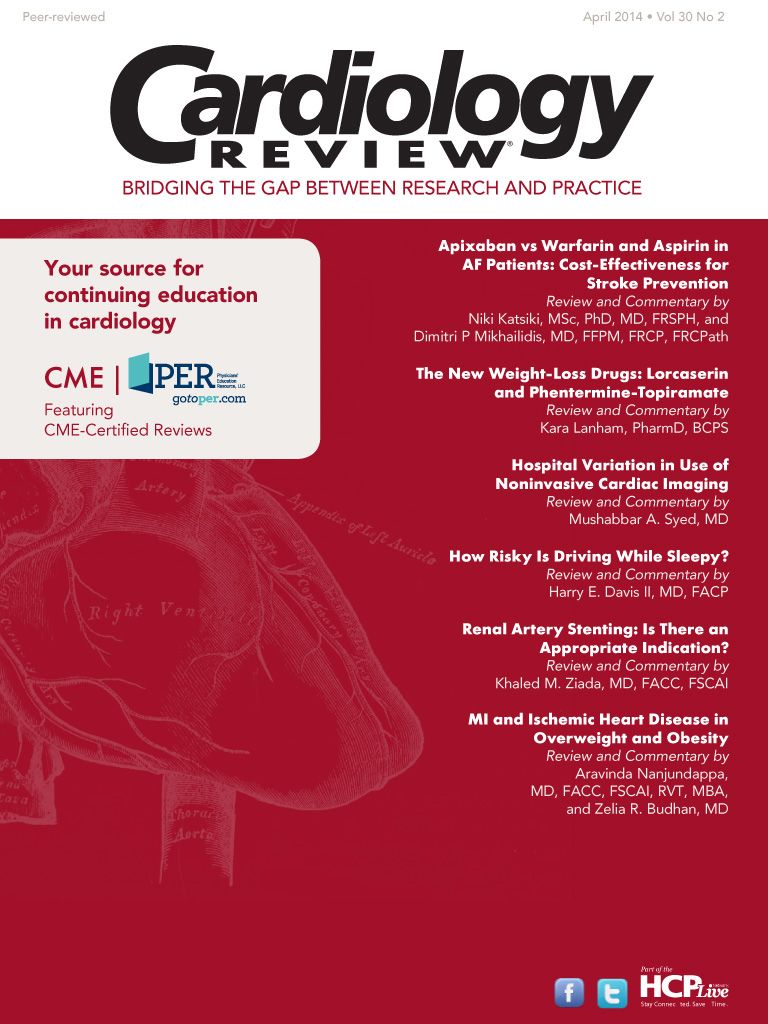Publication
Article
Cardiology Review® Online
Apixaban versus Warfarin and Aspirin in AF Patients: Cost-Effectiveness for Stroke Prevention
An examination of the cost-effectiveness of novel oral anticoagulants for stroke prevention in atrial fibrillation patients.

Niki Katsiki, MSc, PhD, MD, FRSPH, and
Dimitri P Mikhailidis, MD, FFPM, FRCP, FRCPath
Review
Dorian P, Kongnakorn T, Phatak H, et al. Cost-effectiveness of apixaban vs. current standard of care for stroke prevention in patients with atrial fibrillation [published online February 16, 2014]. Eur Heart J.

Atrial fibrillation (AF) is a major cause of stroke and thromboembolic events.1 Recently, novel oral anticoagulants (NOACs) have been approved to prevent stroke incidence in AF patients, and as alternatives to vitamin K antagonists (VKA) and aspirin in patients requiring stroke prevention.2 Among the NOACs, apixaban was shown in the ARISTOTLE trial to be superior to warfarin in prevention of stroke and systemic embolism, bleeding risk, and mortality.3 Furthermore, apixaban was superior to aspirin in stroke and systemic embolism prevention and non-inferior in major bleeding in the AVERROES trial.4 In the present study, Dorian et al5 developed a lifetime Markov model to assess differences in cost-effectiveness of apixaban, compared with warfarin and aspirin in VKA-suitable and VKA-unsuitable patients, respectively. Quality-adjusted life-years (QALYs) and life expectancy were also compared.
Study Details
Dorian et al5 assessed health care costs, life years, and QALYs in patients with non-valvular AF treated with apixaban (an oral inhibitor of coagulation factor Xa), warfarin, or aspirin from a UK perspective. Data were drawn from the ARISTOTLE3 and the AVERROES trials.4 Briefly, in the ARISTOTLE study (duration, 1.8 years),3 apixaban treatment was associated with significantly fewer primary outcomes (ie, ischemic or hemorrhagic stroke or systemic embolism) (hazard ratio [HR], 0.79; 95% confidence interval [CI], 0.66-0.95; P < .001 for inferiority and P = .01 for superiority), fewer major bleeds (HR, 0.69; 95% CI, 0.60-0.80; P < .001), and fewer all-cause deaths (HR, 0.89; 95% CI, 0.80-0.99; P = .047) compared with warfarin in AF patients. Similarly, in the AVERROES trial (duration, 1.1 years),4 apixaban therapy resulted in significantly fewer primary outcomes (stroke or systemic embolism) (HR, 0.45; 95% CI, 0.32-0.62; P < .001) compared with aspirin in AF patients who were not suitable for VKA; no differences were recorded in major bleeding or mortality rates.
In Dorian and colleagues’5 analysis, among 1000 AF patients over a lifetime, 20 fewer strokes (both first and recurrent ischemic or hemorrhagic strokes) or systemic embolisms, 44 fewer major bleeds, and 21 fewer cardiovascular (CV) deaths were predicted for those patients on apixaban compared with warfarin; the corresponding values in comparison to aspirin were 66 fewer strokes or systemic embolisms and 57 fewer CV deaths for apixaban- treated patients. Furthermore, over a lifetime, 56 and 18 patients needed to be treated with apixaban to prevent 1 stroke, compared with warfarin and aspirin, respectively, whereas 26 additional patients needed to be treated with apixaban to cause 1 major bleed compared with aspirin.5
These apixaban-induced beneficial effects on CV morbidity and mortality were related to an incremental cost-effectiveness ratio (ICER) of £11,909 and £7196 per QALY gained when compared with warfarin and aspirin, respectively.5 Of note, £20,000 per added QALY is a commonly used threshold value that UK payers are willing to pay. Additionally, the ICERs were even more favorable in high-risk patients (baseline CHADS2 ≥3; £9769 and £3331 per QALY when compared with warfarin and aspirin, respectively) compared with low-risk patients (baseline CHADS2 ≤1; £13,152 and £16,744 per QALY when compared with warfarin and aspirin, respectively) and those with CHADS2 = 2 (£13,262 and £6848 per QALY when compared with warfarin and aspirin, respectively). Similarly, in a subgroup analysis according to international normalized ratio (INR) control quality, apixaban was shown to be cost-effective (£11,321 per QALY gained) even in well-controlled patients (with mean time in therapeutic range >76.5%).5
The authors concluded that apixaban was more effective in reducing clinical events, increasing life expectancy, and gaining QALYs than warfarin and aspirin, though more costly. However, the higher cost was due not only to higher drug costs but also to longer treatment duration and lower discontinuation rates compared with warfarin and aspirin. Overall, Dorian and colleagues’5 analysis showed that apixaban is considered a cost-effective alternative for the prevention of thromboembolic events in AF patients, regardless of baseline stroke risk and INR control.
CommentaryCost-Effective Regardless of Baseline Stroke Risk
VKAs were until recently the only available oral anticoagulant treatments to prevent stroke incidence in AF patients, with aspirin being the alternative therapeutic option in the presence of VKA contraindications or intolerance.6 However, the increased risk of bleeding was a hard “price to pay” in patients on VKA or aspirin, also leading to high discontinuation rates. NOACs have been recently approved for stroke prevention in AF patients, namely dabigatran (a direct thrombin inhibitor) and rivaroxaban and apixaban (direct factor Xa inhibitors).7 These agents were shown to be superior, or at least non-inferior, to warfarin for stroke prevention, bleeding risk, and all-cause mortality, with an additional benefit of fixed-dose administration without a need for routine coagulation monitoring.7 A recent meta-analysis reported that NOACs were superior to warfarin in preventing stroke (or systemic embolism) and all-cause mortality, without increasing the risk of major bleeding.8
In the Dorian et al study5 apixaban was found to be cost-effective for the prevention of thromboembolic events in AF patients compared with warfarin and aspirin. Similarly, rivaroxaban and dabigatran were cost-effective versus warfarin or aspirin in previous analyses.9
More important, a recent study reported that apixaban (5 mg twice daily) may also be a cost-effective alternative to rivaroxaban (20 mg once daily) and dabigatran (110 mg or 150 mg twice daily) for preventing stroke in the presence of AF from a UK perspective (ICERs £5305, £4497, and £9611 per QALY gained, respectively).10 From a US perspective (at a threshold of $100,000), ICERs were $93,063, $111,465, and $140,557 per QALY gained for apixaban, rivaroxaban, and dabigatran (150 mg) compared with warfarin. Therefore, apixaban was the optimal anticoagulant therapy, although warfarin was also considered an optimal choice in sensitivity analysis.11 In another US analysis12 apixaban, rivaroxaban, and dabigatran (150 mg) were all cost-effective alternatives to warfarin, with apixaban having the highest QALY estimate, though it was more costly. Of note, using genotype to guide the selection of warfarin or NOAC treatment was recently reported to be cost-effective.13
However, these findings are based on indirect comparisons of available data in the absence of head-to-head trials and thus should be interpreted with caution. In real-life settings, treatment adherence and provided health care may be not achieved at the level of a clinical trial, possibly leading to lower efficacy, safety, and tolerability as highlighted by Dorian et al.5 Furthermore, concomitant diseases and their treatment may influence overall cost-effectiveness. In this context, controlling diabetes with either oral hypoglycemic agents or insulin is important in terms of both clinical outcomes and costs.14 Statin therapy was associated with significantly reduced CV morbidity and mortality in patients at low CV risk in a previous meta-analysis.15 Even high-potency statins were cost-effective in patients at low CV risk (assuming that statin- related benefits would continue for no less than 10 years).16 Statins became highly cost-effective in primary prevention with the introduction of low-cost generic agents.17 In secondary prevention settings, high-potency statins at high doses are cost-effective compared with low-potency statins.18 Similar benefits have been reported for antihypertensive drugs.19 Polypills containing a statin, aspirin, and antihypertensive drugs were also found to be cost-effective in primary prevention models.20 Based on the above, there may also be differences in effectiveness of NOACs depending on patient risk for vascular events or bleeding.
Pharmacogenetic-guided treatments may also affect clinical outcomes and cost-effectiveness.21 Of note, sponsored cost-effectiveness analyses may be more likely to produce a favorable cost-effective profile; therefore such analyses should be interpreted with caution.22
In conclusion, Dorian et al5 reported that apixaban is a cost-effective alternative to warfarin and aspirin for the prevention of thromboembolic events in AF patients, regardless of baseline stroke risk and INR control. However, a key issue is which NOAC to use in each case, taking into consideration not only patient characteristics (eg, chronic kidney disease, older age, history of coronary heart disease, stroke, or transient ischemic attack) but also cost-effectiveness.23 Head-to-head trials in matched populations are needed to answer this question.
References
1. Lubitz SA, Bauer KA, Benjamin EJ, et al. Stroke prevention in atrial fibrillation in older adults: existing knowledge gaps and areas for innovation: a summary of an American Federation for Aging research seminar. J Am Geriatr Soc. 2013;61:1798-1803.
2. McGrath ER, Eikelboom JW, Kapral MK, O’Donnell MJ. Novel oral anticoagulants: a focused review for stroke physicians. Int J Stroke. 2014;9:71-78.
3. Granger CB, Alexander JH, McMurray JJ, et al; Committees A, Investigators. Apixaban versus warfarin in patients with atrial fibrillation. N Engl J Med. 2011;365:981-992.
4. Connolly SJ, Eikelboom J, Joyner C, et al. Committee AS, Investigators. Apixaban in patients with atrial fibrillation. N Engl J Med. 2011;364:806-817.
5. Dorian P, Kongnakorn T, Phatak H, et al. Cost-effectiveness of apixaban vs. current standard of care for stroke prevention in patients with atrial fibrillation [published online February 16, 2014]. Eur Heart J.
6. Camm AJ, Lip GY, De Caterina R, et al; ESC Committee for Practice Guidelines (CPG). 2012 focused update of the ESC Guidelines for the management of atrial fibrillation: an update of the 2010 ESC Guidelines for the management of atrial fibrillation: developed with the special contribution of the European Heart Rhythm Association. Eur Heart J. 2012;33:2719-2747.
7. Hankey GJ, Eikelboom JW. Novel oral anticoagulants for atrial fibrillation. Curr Atheroscler Rep. 2013;15:344.
8. Capodanno D, Capranzano P, Giacchi G, Calvi V, Tamburino C. Novel oral anticoagulants versus warfarin in non-valvular atrial fibrillation: a meta-analysis of 50,578 patients. Int J Cardiol. 2013;167:1237-1241.
9. Kansal AR, Zheng Y, Pokora T, Sorensen SV. Cost-effectiveness of new oral anticoagulants in the prevention of stroke in patients with atrial fibrillation. Best Pract Res Clin Haematol. 2013;26:225-237.
10. Lip GY, Kongnakorn T, Phatak H, et al. Cost-effectiveness of apixaban versus other new oral anticoagulants for stroke prevention in atrial fibrillation. Clin Ther. 2014;36:192-210.
11. Canestaro WJ, Patrick AR, Avorn J, et al. Cost-effectiveness of oral anticoagulants for treatment of atrial fibrillation. Circ Cardiovasc Qual Outcomes. 2013;6:724-731.
12. Harrington AR, Armstrong EP, Nolan PE Jr, Malone DC. Cost-effectiveness of apixaban, dabigatran, rivaroxaban, and warfarin for stroke prevention in atrial fibrillation. Stroke. 2013;44:1676-1681.
13. You JH. Novel oral anticoagulants versus warfarin therapy at various levels of anticoagulation control in atrial fibrillation-a cost-effectiveness analysis. J Gen Intern Med. 2014;29:438- 446.
14. Ward A, O’Brien JA, Salas M. Cost-effectiveness of oral hypoglycaemic agents for the treatment of type 2 diabetes mellitus. Expert Opin Pharmacother. 2005;6(4):601-608.
15. Tonelli M, Lloyd A, Clement F, et al; Alberta Kidney Disease Network. Efficacy of statins for primary prevention in people at low cardiovascular risk: a meta-analysis. CMAJ. 2011;183:E1189-E1202.
16. Conly J, Clement F, Tonelli M, et al; Alberta Kidney Disease Network. Cost effectiveness of the use of low- and high-potency statins in people at low cardiovascular risk. CMAJ. 2011;183:E1180-E1188.
17. Mitchell AP, Simpson RJ. Statin cost effectiveness in primary prevention: a systematic review of the recent cost-effectiveness literature in the United States. BMC Res Notes. 2012;5:373.
18. Ara R, Pandor A, Stevens J, et al. Prescribing high-dose lipid-lowering therapy early to avoid subsequent cardiovascular events: is this a cost-effective strategy? Eur J Prev Cardiol. 2012;19:474-483.
19. Wisløff T, Selmer RM, Halvorsen S, Fretheim A, Norheim OF, Kristiansen IS. Choice of generic antihypertensive drugs for the primary prevention of cardiovascular disease: a cost-effectiveness analysis. BMC Cardiovasc Disord. 2012;12:26.
20. van Gils PF, Over EA, Hamberg-van Reenen HH, et al. The polypill in the primary prevention of cardiovascular disease: cost-effectiveness in the Dutch population. BMJ Open. 2011;1:e000363.
21. Sorich MJ, Wiese MD, O’Shea RL, Pekarsky B. Review of the cost effectiveness of pharmacogenetic- guided treatment of hypercholesterolaemia. Pharmacoeconomics. 2013;31:377-391.
22. Catalá-López F, Sanfélix-Gimeno G, Ridao M, Peiró S. When are statins cost-effective in cardiovascular prevention? a systematic review of sponsorship bias and conclusions in economic evaluations of statins. PLoS One. 2013;8:e69462.
23. Cairns JA. Which oral anticoagulant for which atrial fibrillation patient: recent clinical trials and evidence-based choices. Can J Cardiol. 2013;29: 1165-1172.
About the Author
N
iki
K
atsiki
, MSC, PhD, MD, FRSPH,
is a specialist in internal medicine and a researcher at the Medical School, Aristotle University of Thessaloniki, Thessaloniki, Greece. Her PhD is based on obesity-related peptides in diabetic patients. Dr. Katsiki’s clinical and research interests involve cardiovascular disease prevention and treatment. She has participated in obesity, lipid, diabetes, peripheral artery disease, and smoking cessation outpatient clinics with a special focus on dyslipidemias. Dr. Katsiki was an Honorary Clinical Research Fellow at the Department of Clinical Biochemistry (Academic Head, DP Mikhailidis), Royal Free Hospital campus, University College London Medical School, University College London (UCL), UK. She is also a SCOPE member of the International Association for the Study of Obesity. Dr. Katsiki serves as a reviewer for several cardiovascular journals and is the Editorial Manager of Angiology and Section Editor of Archives of Medical Science. She was assisted in the writing of this article by Dimitri P. Mikhailidis, BSc, MSc, MD, FRSPH, FCP, FFPM, FRCP, FRCPath, Academic Head of the Department of Clinical Biochemistry (Vascular Disease Prevention Clinics), and Department of Surgery, Royal Free Campus, University College London Medical School, UCL, London, UK. He is Editor-in-Chief of several journals including Current Medical Research and Opinion, Current Vascular Pharmacology, and Expert Opinion on Pharmacotherapy.






